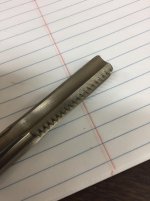I was working on threading an aluminum oxygen cylinder for my potato gun when I broke my 3/8" 4 flute threadmill. I don't remember when I bought it, but I was shocked to see how much they cost (Around $60-80+++). Since I don't use my mill (Fadal VMC15) on a regular basis, I expect to break bits from time to time, but at $60 each, I can't justify having too many of those around. Because of that, it got me looking at alternatives
like this post which looked promising:
https://www.practicalmachinist.com/...threading-bar-271469-post2130865/#post2130865
If you like that and want to try it out, the insert is a TPMG:
https://www.ebay.com/itm/7-VR-WESSO...e=STRK:MEBIDX:IT&_trksid=p2057872.m2749.l2649
As I was sorting through some endmills, I found some HSS T-Slot cutters and was wondering about just putting some angles on something like this one:
KLOT HRC55 T Slot Keyseat Milling Cutter Solid Carbide End Mill 3mm-4mm CNC | eBay
Or this:
Select Cutting Diameter 12 14 16 - 3�mm Carbide Tip T Slot Cutter End Mill Tool | eBay
I have a surface grinder I have almost never used along with a nice rotary indexer that I have never used and was thinking of giving it a try but figured it is always a good idea to check with the experts before ruining something good.
like this post which looked promising:
https://www.practicalmachinist.com/...threading-bar-271469-post2130865/#post2130865
If you like that and want to try it out, the insert is a TPMG:
https://www.ebay.com/itm/7-VR-WESSO...e=STRK:MEBIDX:IT&_trksid=p2057872.m2749.l2649
As I was sorting through some endmills, I found some HSS T-Slot cutters and was wondering about just putting some angles on something like this one:
KLOT HRC55 T Slot Keyseat Milling Cutter Solid Carbide End Mill 3mm-4mm CNC | eBay
Or this:
Select Cutting Diameter 12 14 16 - 3�mm Carbide Tip T Slot Cutter End Mill Tool | eBay
I have a surface grinder I have almost never used along with a nice rotary indexer that I have never used and was thinking of giving it a try but figured it is always a good idea to check with the experts before ruining something good.




